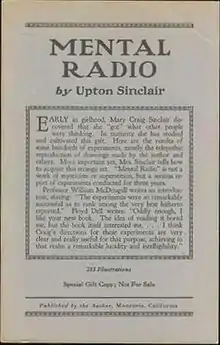Mental Radio
Mental Radio: Does it work, and how? (1930) was written by the American author Upton Sinclair and initially self-published. This book documents Sinclair's test of psychic abilities of Mary Craig Sinclair, his second wife, while she was in a state of profound depression with a heightened interest in the occult. She attempted to duplicate 290 pictures which were drawn by her brother. Sinclair claimed Mary successfully duplicated 65 of them, with 155 "partial successes" and 70 failures. The experiments were not conducted in a controlled scientific laboratory environment.[1]
 First edition (self-published) | |
| Author | Upton Sinclair |
|---|---|
| Country | United States |
| Language | English |
| Subject | Telepathy |
| Published | 1930 |
| Media type | |
| OCLC | 2012635 |
The German edition included a preface written by Albert Einstein who admired the book and praised Sinclair's writing abilities.[2] The psychical researcher Walter Franklin Prince conducted an independent analysis of the results in 1932. He believed that telepathy had been demonstrated in Sinclair's data. Prince's analysis was published as "The Sinclair Experiments for Telepathy" in Part I of Bulletin XVI of the Boston Society for Psychical Research in April, 1932 and was included in the addendum for the book.[3]
Critical reception
On the subject of occult and pseudoscience topics, Sinclair has been described as credulous.[4] Martin Gardner wrote "As Mental Radio stands, it is a highly unsatisfactory account of conditions surrounding the clairvoyancy tests. Throughout his entire life, Sinclair has been a gullible victim of mediums and psychics."[1] Gardner also wrote the possibility of sensory leakage during the experiment had not been ruled out:
In the first place, an intuitive wife, who knows her husband intimately, may be able to guess with a fair degree of accuracy what he is likely to draw—particularly if the picture is related to some freshly recalled event the two experienced in common. At first, simple pictures like chairs and tables would likely predominate, but as these are exhausted, the field of choice narrows and pictures are more likely to be suggested by recent experiences. It is also possible that Sinclair may have given conversational hints during some of the tests—hints which in his strong will to believe, he would promptly forget about. Also, one must not rule out the possibility that in many tests, made across the width of a room, Mrs. Sinclair may have seen the wiggling of the top of a pencil, or arm movements, which would convey to her unconscious a rough notion of the drawing.[1]
When Mrs. Sinclair was tested by William McDougall under better precautions the results were less than satisfactory.[1]
References
- Martin Gardner. Fads & Fallacies in the Name of Science (Courier Dover Publications, 1957) Chapter 25: ESP and PK, available online, accessed July 25, 2010.
- Lauren Coodley. (2013). Upton Sinclair: California Socialist, Celebrity Intellectual. Bison Books. pp. 104-106.
- Walter Franklin Prince. (1932). Mrs. Sinclair's Mental Radio. Scientific American. Volume 146: 135-38.
- Dieter Herms. (1990). Upton Sinclair: Literature and Social Reform. New York: Peter Lang. p. 62.
Further reading
- Leon Harris. (1975). Upton Sinclair, American Rebel. Crowell.
